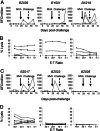Theileria parva candidate vaccine antigens recognized by immune bovine cytotoxic T lymphocytes
- PMID: 16492763
- PMCID: PMC1413922
- DOI: 10.1073/pnas.0511273103
Theileria parva candidate vaccine antigens recognized by immune bovine cytotoxic T lymphocytes
Abstract
East Coast fever, caused by the tick-borne intracellular apicomplexan parasite Theileria parva, is a highly fatal lymphoproliferative disease of cattle. The pathogenic schizont-induced lymphocyte transformation is a unique cancer-like condition that is reversible with parasite removal. Schizont-infected cell-directed CD8(+) cytotoxic T lymphocytes (CTL) constitute the dominant protective bovine immune response after a single exposure to infection. However, the schizont antigens targeted by T. parva-specific CTL are undefined. Here we show the identification of five candidate vaccine antigens that are the targets of MHC class I-restricted CD8(+) CTL from immune cattle. CD8(+) T cell responses to these antigens were boosted in T. parva-immune cattle resolving a challenge infection and, when used to immunize naïve cattle, induced CTL responses that significantly correlated with survival from a lethal parasite challenge. These data provide a basis for developing a CTL-targeted anti-East Coast fever subunit vaccine. In addition, orthologs of these antigens may be vaccine targets for other apicomplexan parasites.
Conflict of interest statement
Conflict of interest statement: No conflicts declared.
Figures




Similar articles
-
Evaluation of the recognition of Theileria parva vaccine candidate antigens by cytotoxic T lymphocytes from Zebu cattle.Vet Immunol Immunopathol. 2008 Feb 15;121(3-4):216-21. doi: 10.1016/j.vetimm.2007.09.012. Epub 2007 Oct 2. Vet Immunol Immunopathol. 2008. PMID: 17983665
-
Orientation of bovine CTL responses towards PIM, an antibody-inducing surface molecule of Theileria parva, by DNA subunit immunization.Vet Immunol Immunopathol. 2008 Aug 15;124(3-4):253-63. doi: 10.1016/j.vetimm.2008.03.009. Epub 2008 Mar 29. Vet Immunol Immunopathol. 2008. PMID: 18466981
-
Treatment of cattle with DNA-encoded Flt3L and GM-CSF prior to immunization with Theileria parva candidate vaccine antigens induces CD4 and CD8 T cell IFN-γ responses but not CTL responses.Vet Immunol Immunopathol. 2011 Apr 15;140(3-4):244-51. doi: 10.1016/j.vetimm.2010.12.013. Epub 2011 Jan 18. Vet Immunol Immunopathol. 2011. PMID: 21288576
-
Designing bovine T cell vaccines via reverse immunology.Ticks Tick Borne Dis. 2012 Jun;3(3):188-92. doi: 10.1016/j.ttbdis.2011.12.001. Epub 2012 Jan 9. Ticks Tick Borne Dis. 2012. PMID: 22621863 Review.
-
Cellular immunity against Theileria parva and its influence on parasite diversity.Res Vet Sci. 2001 Feb;70(1):77-81. doi: 10.1053/rvsc.2000.0426. Res Vet Sci. 2001. PMID: 11170857 Review.
Cited by
-
Immuno-informatics Analysis to Identify Novel Vaccine Candidates and Design of a Multi-Epitope Based Vaccine Candidate Against Theileria parasites.Front Immunol. 2018 Oct 15;9:2213. doi: 10.3389/fimmu.2018.02213. eCollection 2018. Front Immunol. 2018. PMID: 30374343 Free PMC article.
-
Genetic Diversity and Sequence Polymorphism of Two Genes Encoding Theileria parva Antigens Recognized by CD8+ T Cells among Vaccinated and Unvaccinated Cattle in Malawi.Pathogens. 2020 Apr 30;9(5):334. doi: 10.3390/pathogens9050334. Pathogens. 2020. PMID: 32365795 Free PMC article.
-
Flow Cytometric Analysis of the Cytotoxic T-Cell Recall Response to Theileria parva in Cattle Following Vaccination by the Infection and Treatment Method.Vet Sci. 2021 Jun 18;8(6):114. doi: 10.3390/vetsci8060114. Vet Sci. 2021. PMID: 34207122 Free PMC article.
-
The genomes of three stocks comprising the most widely utilized live sporozoite Theileria parva vaccine exhibit very different degrees and patterns of sequence divergence.BMC Genomics. 2015 Sep 24;16:729. doi: 10.1186/s12864-015-1910-9. BMC Genomics. 2015. PMID: 26403690 Free PMC article.
-
Construction of a genetic map for Theileria parva: identification of hotspots of recombination.Int J Parasitol. 2011 May;41(6):669-75. doi: 10.1016/j.ijpara.2011.01.001. Epub 2011 Feb 23. Int J Parasitol. 2011. PMID: 21310160 Free PMC article.
References
-
- Radley D. E., Brown C. G. D., Cunningham M. P., Kimber C. D., Musisi F. L., Payne R. C., Purnell R. E., Stagg S. M., Young A. S. Vet. Parasitol. 1975;1:35–41.
-
- Uilenberg G. Trop. Med. Int. Health. 1999;4:A12–A20. - PubMed
-
- Good M. F. Trends Parasitol. 2005;21:29–34. - PubMed
-
- Morrison W. I., Goddeeris B. M., Teale A. J., Groocock C. M., Kemp S. J., Stagg D. A. Parasite Immunol. 1987;9:563–578. - PubMed
Publication types
MeSH terms
Substances
LinkOut - more resources
Full Text Sources
Research Materials

